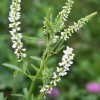 Overview
Overview
Sweet clover, also known as Melilot, originally came from Europe and Asia. It is a leguminous plant with a sweet smell due to its high coumarin content. Actually, there are various plants that belong to the Melilot genus and there are about 19 species in the Melilotus genus. However, in this article, I will be discussing the 2 subtypes of sweet clover: White-flowered and Yellow-flowered.
Economic Status
Melilot arrived in United States during the colonial period and has pretty much been distributed throughout the world. It may be seen growing around fences as a weed. It did not become a marketable plant until at least the last 60 years ago.
Information on White Sweet Clover
The white-flowered sweet clover is a biennial plant that is longer with coarsed-stem and coarser leaves than its counterpart. It can produce many seeds that floats in water and can reach 2 to 5 meters in height. This particular clover was brought to North America in the 17th century and it has been utilized for various purposes. It has also been introduced to South Africa and New Zealand. Some of the uses of white-flowered sweet clover include source of nectar, as an anticoagulant and for its nitrogen fixing ability in preparing soil for farming. Of course, white sweet clover differs from yellow sweet clover by the presence of white rather than yellow flowers. Its seed pods tend to be black to dark grey with single-seeded feature. Normally, the plant flowers and die during the second year of growth. However, flowering occurs basically from june to October of each year.
Tips on Yellow Sweet Clover
Yellow Melilot, also called Yellow Sweet Clover, has been used for various purposes. As a food, the roots and leaves have been made into edible usage which are often cooked as vegetables. In addition, cheeses are flavored with either flowers or seeds of yellow melilot. A number of other uses have been found with yellow sweet clover such as a laxative, tonic, blood thinner, for hemorrhoids, varicose veins as well as flatulence. Dried leaves of sweet clover has been found to be useful throughtout history. An improperly dried leaves can form a blood thinner while a properly dried leaves may be used in controlling pests. Other benefit include usage as a tea to control sleep and tension.
Sweet Clover as a Poison
In general, sweet clover, has been found to function as a poison. Basically, poisoning occurs during a condition in which sweet clover hay or silage is ingested on regular basis for long period of time. During this accumulation, bleeding is remarkably the hallmark of the poisoning. Of course, it becomes apparent that clotting problem exist because of continous bleeding. Most of the instances of sweet clover poisoning occurs in animals such as cattle, sheep as well as horses. The unintentional poisoning of animals may be controlled by introducing cultivars of sweet clover that has minimal amount of coumarin. In addition, using other roughage can help avoid unintentional poisoning.
Conclusion
Sweet clover plant has played a significant role in agriculture today. Many of the farms located throughout the world has had a bit of support with this plant. Its use has been credited as a reliable source of nitrogen-rich organic matter. To study the plant require extensive research because of the numerous species involved in the genus Melilotus. Its major role in modern medicine today has been through its constituent popularly known as coumarin. Sweet clover should be preserved because it has a significant economic use in the world today.
, Sweet Clover Plant: Origin, History and Uses www.ozeldersin.com bitirme tezi,ödev,proje dönem ödevi
